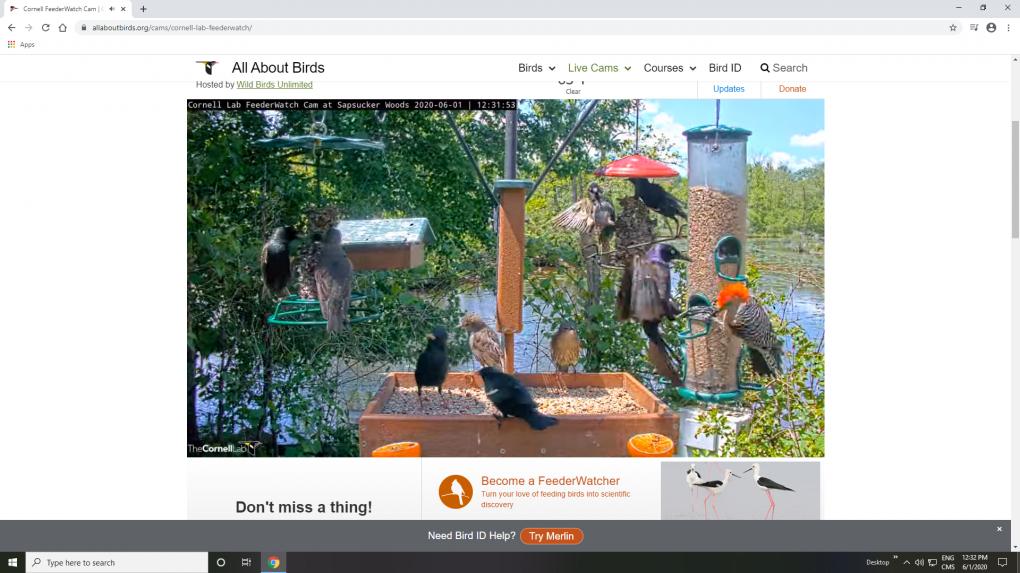The Cornell Lab Bird Academy › Discussion Groups › Joy of Birdwatching › Activities: Bird ID Practice
-
although here for the birds...particularly fond of the gluttonous squirrel just laying in the seed.

-
Beautiful variety of birds in your picture I also love the squirrel
-
-
Activity 1: used the cornell feeder webcam in seersucker woods. saw the red bellied wood pecker and i think the blue jay, but Merlin keeps giving me ducks to choose from when i put in the search criteria (and i am not choosing duck size, or even those colors). But loving the webcam!
-
Activity 4: One of my favorites, Snowy Egret: Size & Shape: This is fairly important, especially if your sighting is through flight. At a glimpse, they can look very similar to gulls, as they don't have any extreme patterns or colorings to distinguish them at a distance. With a closer look, however, the shape is drastically different. Their folded neck makes the appearance of a large lump behind & below the head, and the wingspan is much greater proportionally, with wingspan superseding their size far more than any gull. On the more obvious side of things, they are also larger than any gull or other seabird. Their dagger-like bill is also an easily distinguishable aspect to them. Color & Patterns: Snowy Egrets are pure white, with no patterns to be seen. While this can be seen as a bad thing to have a lack of field marks, there are few other birds to compare it to that have the same completely pure white, and all of them are drastically different in size & shape. Range: Snowy Egrets are only ever seen in the lower half of North America, and drift down to almost purely Mexico & surrounding areas in non-breeding seasons.
-
Activity 2 (if a little incomplete)— lately, I’ve been in Utah enjoying the swallows and swifts from my window. I’m seeing a lot of violet green swallows and white throated swifts. Their darting around makes it hard to differentiate sometimes, but on the swift, there seems to be a band of white on the side against blotches of dark on the belly. Violet green swallows feature a much more clean break between the dark backside and the white belly.
-
Activity 1: Two species I commonly get on my feeder are Black-Capped Chickadees and White-Breasted Nuthatches. They have similar colorings, but you can tell them apart because the Nuthatches are larger and more slender, and also behave differently. Chickadees tend to perch, while Nuthatches will climb up and down the side of trees or our suet feeder. Activity 2: Downy Woodpeckers, Red-Bellied Woodpeckers, and Pileated Woodpeckers all have Black, White, and Red, but they can easily be told apart. First because of the size (Downy is smaller then Red-Bellied is smaller than Pileated), and the Pileated has a crest while the others do not. However, the color patterns are also different. Downys have only a small patch of red, white on the stomach and on spots on the wings and a white stripe on the back, and the rest is black. Red-Bellieds have red across the entire head and a ladder-like pattern of black and white on the back, also white on the stomach. Finally, Pileated have a red crest and are mostly black otherwise save for white patches on the neck and head. Activity 3: A Downy Woodpecker visited my suit feeder. Woodpeckers in general seem to really like the suet, whereas I rarely see them on the seeds. A Tufted Titmouse is now visiting my sunflower seed feeder, and they rarely visit the suet. However, we also get White-Breasted Nuthatches, which like both the seeds and the suet. Other birds, particularly Chipping Sparrows and Mourning Doves like the seeds, but tend to pick seeds from the ground that were dropped by other birds. As for birds that are looking for food on their own, we get American Robins and recently a recurring singular Wild Turkey that forage through the grass looking for worms and other insects. Activity 4: I can't pick a favorite bird, I love them all. But one bird I've been seeing alot lately is a House Wren, which has made a nest in our next box and spends alot of time on a tree outside my window. House Wrens are small bundles of energy, mostly buff colored but with some white on the stomach. They have short, upright tails and short beaks. This particular one likes to sing and is often close enough that I can see its mouth open and its throat moving.
-
I wrote a whole thing for this but then I lost it all because the site logged me out and it took like 15 minutes to write fix this site please.
-
Ok I finally retrieved it by hitting the back arrow enough, but this is still a major issue that could happen to other people, so please fix.
-
-

-
Activity 4: Earlier today I went birding at Centennial Marsh State Wildlife Management Area in Idaho. While driving slowly along one of the perimeter roads, I was scanning the nearby vegetation. I had moved from driving along a distinctly marshy area with patches of open water to a drier area that was slightly higher when I saw a tallish brown shape that did not look quite right for vegetation. Looking thru my binoculars I saw an owl in the middle of the day. The owl was rather slim and long appearing and dark mottled brown with yellow eyes framed in white feathers and two very short ear tufts. It was one of 3 possible large or largish owls that reside in southern Idaho - great horned owl, long-eared owl, and short-eared owl. This owl was slim so the shape eliminated great horned owl, as did it being active during the day and in short vegetation (shrub-steppe). Long-eared owls are also slim but have long ear tufts and tend to roost in tall dense shrubs during the day. I’m not aware of long-eared owls hunting during the day but knew short-eared owls do when the food demands of their owlets gets high enough. Mid-June is about the right time of year for that at the elevation I was at. My owl was indeed a short-eared owl.
-
Great description of your thinking process. I found it helpful.
-
-
Actividad 1 Las aves que encontre y pude distinguir por su forma fueron: Carpintero Andino (Colaptes Rupicola), y el Vencejo Andino (Aeronautes Andecolus), Actividad 2 Los tres pájaros que encontré que tiene el mismo color en diferentes partes del cuerpo son: Jilguero Vientre Amarillo (Spinus xanthogastrus) que tiene Capucha oscura, pecho amarillo, y alas con parches amarillos Jilguero (Spinus Atratus) que tiene pecho y capucha oscuro, alas oscuras con parches amarillos, cola interna amarilla Jilguero Lomo amarillo (Spinus Uropygialis) que tiene capucha oscura, pecho amarillo alas oscuras con amarillo Actividad 3 Los tres pájaros que encontré buscando comida son: Pichitanka (Zonotrichia Capensis), que busca su comida en el suelo ya que como granos Picaflor Verde (Colibri Curuscans), que busca su comida en las flores tubulares ya que se alimenta del néctar de las mismas Vencejo Andino (Aeronautes Andecolus) que busca su comida volando ya que se alimenta de pequeños insectos. Actividad 4 Picaflor Cometa (Sappho Sparganura), Tamaño y forma: de tamaño pequeño, tiene la cola mucho mas grande que los demás picaflores y el pico es más pequeño que el del Picaflor Verde (Colibri Curuscans) Patrón de color y marcas: Mascara oscura, pecho verde, cola larga con color tornazolado naranja, rojo y puntas de las plumas de la cola oscura Comportamiento: Volando cerca a flores tubulares y posándose en los arboles cercanos a estas flores para cuidar su territorio, generalmente percha y se alimenta solo. Se alimenta del néctar de las flores, aleteo rápido.
-
Activity 1: Definitely a Robin has a different size shape from a Blue Jay. Activity 2: I saw three different woodpeckers at my feeder-the red headed woodpecker, the red bellied woodpecker and the downy woodpecker. And I thought a woodpecker was a woodpecker! Activity 3: Most of the birds I am watching--cardinals, finches, sparrows, blue jays, woodpeckers, wrens and thrashers-- are eating from my feeder--eating me out of house and home! But robins definitely like the worms in the yard and the little humming bird is enjoying my hummingbird feeder. Activity 4: I think my favorite bird is the robin because I had the opportunity to watch the couple build their next on our gutter downspouts, take turns caring for their nest and feeding their babies--they definitely were a team! Unfortunately something got to the nest before the babies could fly. :-( But I've learned they will rebuild their nests and try again! My second favorite is the cardinal because it is so beautiful--red is my favorite color--and they have a nice sound.
-
Activity 1: On the Cornell FeederWatch Cam, I identified a Red-winged Blackbird and a Mourning Dove, which are easily distinguishable because of their different shapes. The Red-winged Blackbird has a short neck, a slender body, short legs, and a medium beak that is straight. The Mourning Dove has a short neck, short legs, and a medium beak; however, it has a rather chunky body and it’s beak curves slightly downward. Activity 2: Three birds I have seen that have black as a part of their colour pattern are the Black-capped Chickadee, the Bluejay, and the Northern Cardinal (all males). The Black-capped Chickadee has a black crown, a black throat, a black beak, and some black in the primary feathers of the wings. The Bluejay has a black beak, a black necklace, a black eyeline, and black wing-bars. The Northern Cardinal has a black circle surrounding its beak and extending to the throat slightly. It also has a hint of black in its wing feathers. Activity 3: On the Cornell FeederWatch Cam, I observed three different birds eating from the feeders. The Common Grackle stood on the edge of the feeding trough, horizontally, and swiftly dipped its beak down to retrieve some seed, repeatedly. The Red-bellied Woodpecker also ate from the trough. It kept its beak close to the surface of the trough, pecking at the food with its beak several times before lifting its head. The Mourning Dove sat in the trough and rapidly swivelled its head up and down as it ate. Activity 4: My favourite bird lately is the Ruby-throated Hummingbird. I am trying to attract one to my backyard with a hummingbird feeder I bought, but so far I have had no such luck. It is a very small bird; smaller than a finch. It has a long, thin beak that is about twice the width of its head. Its legs are so short that they can hardly be seen. It has a ruby red throat, a green cap, and a white chest. According to my Birds of Ontario field guide, it is present in my area as a breeder from May to August and as a migrant from mid-August to mid-September.
-
Activity #1. I don't have a comparison by shape, but I've been noticing shapes of Phoebes and Sparrows in my yard. I watch the Phoebe's tail for "wagging " when it lights, which it often does on the lamp post or a branch. The round little Sparrow hops around on my driveway. It's either a Song or Chipping, not sure which. I can't see it all that well. Activity #2. I compared the Sparrows and the House Wren, both mostly brown. I've only seen the wren once, though I've heard it quite a few times. The Sparrows have black and white stripes on their heads and wings, and I noticed a bright almost orange cap on the head (chipping?). The wren is brown all over. Activity #3. Within the last few days I've seen the Robin walking around on the driveway pecking at this and that. The Sparrow hops and does quick pecks. the Phoebe flies around and I don't know how it gets it's food. It's a flycatcher, so there you go. Activity #4. Today my favorite is the Red Eyed Vireo. I was hiking, and I kept hearing its cheery song above me. I've been hearing it a lot on my hikes. I finally spotted one without binoculars. It was 20-30 feet up in the understory of hardwood trees, occasionally hopping from branch to branch. It's a bit smaller than a Robin. It seemed cheerful, and it moved around quite a bit. It was white below with some yellow on the sides of the belly. It had a grey cap and a black eye stripe bisecting white stripes. The back is yellow mixed with gray. (I didn't see all that without binoculars!). Red-eyed vireos winter in South America, and spend the breeding season much of th eastern US and some of Canada.
-
I have found paying attention to shape to be helpful to distinguish between white-breasted nuthatches and mountain chickadees in my backyard. While there are definitely distinct differences in markings and behavior, the coloring is similar enough and the birds in my backyard seem to be moving all the time making it harder to catch those differences! One thing I noticed that was really helpful to distinguish between them quickly, even in movement, was the shape of their bill. The chickadees have a much smaller bill than the nuthatches. It has really helped with split second identification!
-
4. A favorite bird, perhaps partly because we can see it easily in this season in southeast Michigan, is the Tree Swallow. It has an extensive summer range in North America but migrates south for the winter. The Tree Swallow seems to be mainly an aerial forager, and it flies (with a glide) over meadows and fields to catch insects. It has very distinctive color markings, including a blue iridescent back and a clean white front and a black mask around its eyes. This bird (a male) is atop a nesting box at about 9 am, June 7, at Matthaei Botanical Gardens (University of Michigan).

-
Activity 1: We've had a lot of European Starlings, Red-winged Blackbirds, and Grackles around here. From a distance they just look black, so I go by the overall shape, specifically tail length compared to body. Activity 3: Recently I've seen the feeding habits of American Robins, Northern Flickers and White-breasted Nuthatches. The first two were ground feeders, while the nuthatch did its feeding on a tree. As an aside, several weeks ago I saw a Belted Kingfisher at a nearby pond doing it's thing. Not the quietest at the buffet line. Activity 4: White-Breasted Nuthatch: Small (and I always find a bit rotund), distinctive band across the head (not quite a full cap), and a distinctive tree climbing behavior.
-
I have been wrestling with the differences among these dark/black birds, too, especially the distinction between the Starling and Grackle. From what I can see a Grackle has a tapered gray bill, fairly long legs, and a long black tail, with a bright yellow eye. Its feathers are dark blue in the neck and head region, and its feathers are iridescent—blue and bronzy. The European Starling has a long yellow bill, speckled brown feathers, a brown tail shorter than that of a grackle, reddish legs shorter than that of a grackle, and a duller eye. (Male) Red-winged Blackbirds, very common here in southeast Michigan near bodies of water, are black, with red shoulder patches with a yellow line and a medium-sized grayish bill. I think I found a Grackle and a Starling at the Sapsucker Woods feeder. Corrections welcome.


-
-

 I looked around my house and was able to take photos of and ID a Northern Cardinal and American Robin. I used my camera because I don't have binoculars yet––and I learned how much of a challenge bird photography is! I'd love to get better at it. I used the Merlin app to identify them by color (both have red and black) but I think the app distinguished them based on behavior. The robin was on the ground while the cardinal was on a branch.
I looked around my house and was able to take photos of and ID a Northern Cardinal and American Robin. I used my camera because I don't have binoculars yet––and I learned how much of a challenge bird photography is! I'd love to get better at it. I used the Merlin app to identify them by color (both have red and black) but I think the app distinguished them based on behavior. The robin was on the ground while the cardinal was on a branch. -
i used Merlin yesterday to identify a bird i had never seen in my yard before. It was a ground feeder , black and gray and i identified it as a gray catbird. exciting
-
I googled live bird cams in my area. Who knew?? The live eagle cam captured an anhinga (water fowl) in the water below the nest.
-
Activity #1: I'm not very good identifying birds by shape, but even I can tell a Northern Cardinal from a Robin based on shape! Activity #2: For the colour activity, I chose three birds that we see in our backyard that each have some red on them. Male Yellow-Bellied Sapsuckers have red on their forehead and throat. Female Northern Cardinals have red on their beak, crest, wings and tail. And male Rose-Breasted Grosbeaks have red on their throat and neck.


 Activity #3: Today I watched a Nuthatch feed by going headfirst down a trunk. A Goldfinch ate seed from our feeder. And a Robin pulled a worm from the ground.
Activity #4: I took a walk this morning through a large town-owned field that has nesting boxes for Tree Swallows. These beautiful birds are about the size of a sparrow. They have stunning iridescent blue backs, while their underparts are white and their wings look black. They are very fast and agile flyers, swooping to feed on flying insects. To me, their song is a very high-pitched chirp that reminds of a piccolo.
Activity #3: Today I watched a Nuthatch feed by going headfirst down a trunk. A Goldfinch ate seed from our feeder. And a Robin pulled a worm from the ground.
Activity #4: I took a walk this morning through a large town-owned field that has nesting boxes for Tree Swallows. These beautiful birds are about the size of a sparrow. They have stunning iridescent blue backs, while their underparts are white and their wings look black. They are very fast and agile flyers, swooping to feed on flying insects. To me, their song is a very high-pitched chirp that reminds of a piccolo. -
Activity 4: Harlequin Duck (Histrionicus histrionicus) - Smaller than a Mallard but larger than a Bufflehead - Diving duck - Both male and female have a small white dot well behind the eye as well as a large white spot that extends down were the eye is until the base of the bill - Males are mottled with orange, blue, and white -Females are mainly a dull light brown


-
Activity 1: birds I can ID by their shape. Mourning doves have a distinctive shape especially when compared to the many finches and sparrows commonly seen in my neighborhood; their long tails and small heads are their most recognizable features. On the other hand, a robin is much more proportionate; its tail is neither long nor stumpy, and its head looks like the right size for its body. Activity 4: describing a favorite bird using mulitple strategies. A red-winged blackbird looks like what it's called: solid glossy black overall, with a squarish patch of red on its "shoulder" or the top of its wing. I always think of it as an epaulet. :) It's around the size of a robin. I see and hear them in areas where different habitats come together, for instance on the edges of a field or meadow that's bordered by trees, or in the tall grass in and around ponds or wetlands. The males are often out and about while the females stay undercover. It took me forever to figure out that the small brown birds darting through the high grass around the pond in a favorite local park are not sparrows but female redwinged blackbirds. Their song is somehow both shrill and guttural, and I've seen it phoneticized in field guides as "kon-ka-REE," but recently I realized it also sounds uncomfortably like "quart-an-TINE," lol. My favorite thing about their song is when I can hear multiple birds calling and responding to one another, for instance when I'm walking down a long straight path and I can hear them "telegraphing" to one another up and down the path.
-
Activity 4. My favorite bird. Probably the cardinal! Size smaller than robin but larger than a sparrow, red and black markings, wonderful whistle calls, to name one, and suburban habitat..
-
. Activity #1. Telling two birds apart by shape. Woodpecker... downy vs hairy... a brief visit at the feeder today included a slightly larger woodpecker... Definitely a male hairy. His size was considerably smaller than a downy but nowhere near pileated or red bellied. We’ve had downys off and on, but this gentleman was larger. activity 2. Food finding behaviors. Watched the male goldfinches vie for a rug on the feeder. So interesting to watch them push each other away. A couple of females behaved similarly...waiting on top of the feeder pole for one to leave the wrung hummingbird passed by the nectar feeder for a go at a pink and red potted plant! crows... are there grubs in the lawn?
-
For activity #1, I decided on the California Scrub Jay and the Black Phoebe. I could tell them apart because the Scrub Jay had a long body and a thick, long bill, and the Phoebe had a small body and short bill. For activity #2 I chose the House Finch, Acorn Woodpecker, and the Spotted Towhee. The House Finch has red on its breast, and sometimes on its head. The Acorn Woodpecker has red on its cap, and the Spotted Towhee has red on its wings. The Spotted Towhee's coloring is more orange than red, but I will still include it in my list. For activity #3 I chose the Oak Titmouse, the Mourning Dove, and the Common Raven. The Oak Titmouse will peck at wood with an uneven tapping, the Mourning Dove will peck at the ground for food, and the Common Raven will hunt for food. For activity #4 I chose the Oak Titmouse. The Oak Titmouse pecks for food on tree branches, is small and has a brownish-gray crest, and is brown, gray, and white. These tools have helped me so much on my birding journey and I notice them more and more every time I see a bird. Thank you for this course!
-
The Joy of birdwatching!! I just connected with the Sapsucker Woods birdcam for the first time, and have immediately become addicted... :) When we see birds, it is usually flying overhead, or flitting through tree branches, or landing on the ground and taking off again. Seeing groups of them do this, and repeatedly.... is wonderful and very helpful in identification and behaviour observation. So I also did it.... repeatedly.... about five minutes per observation. And most of the birds were the same every time, but very varied: starlings, grackles, red-winged blacbirds, a blue jay, a mourning dove and various types of woodpeckers. I thought my biggest identification difficulties were with sparrows (I'd just about given up...) but now I realize how many similar but different types of woodpeckers there are. I think I saw three types: a hairy(?) and-or a downy(?), and possibly a red-bellied. The other thing that surprised me was how civilly they got on together when there were many different species, and how argumentative they became when it was just the blackbirds. I wonder whether that is because they are aware that they are similar species (are they?) and see each other as rivals, but know that a mourning dove or a woodpecker is not. I took a screen shot and will try to append it... Now back to the webcam live.... :)

Read More:
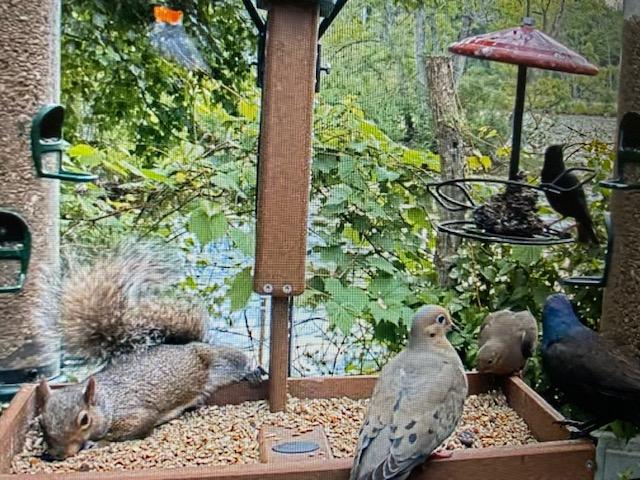
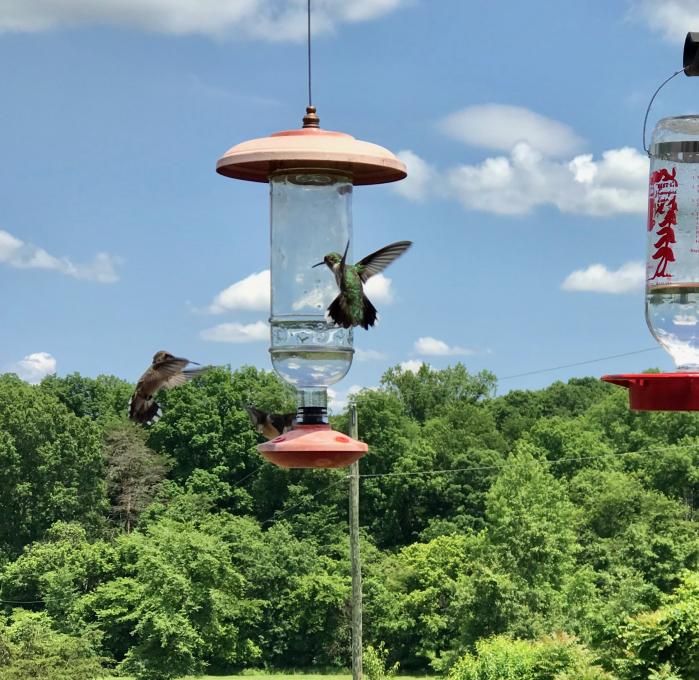


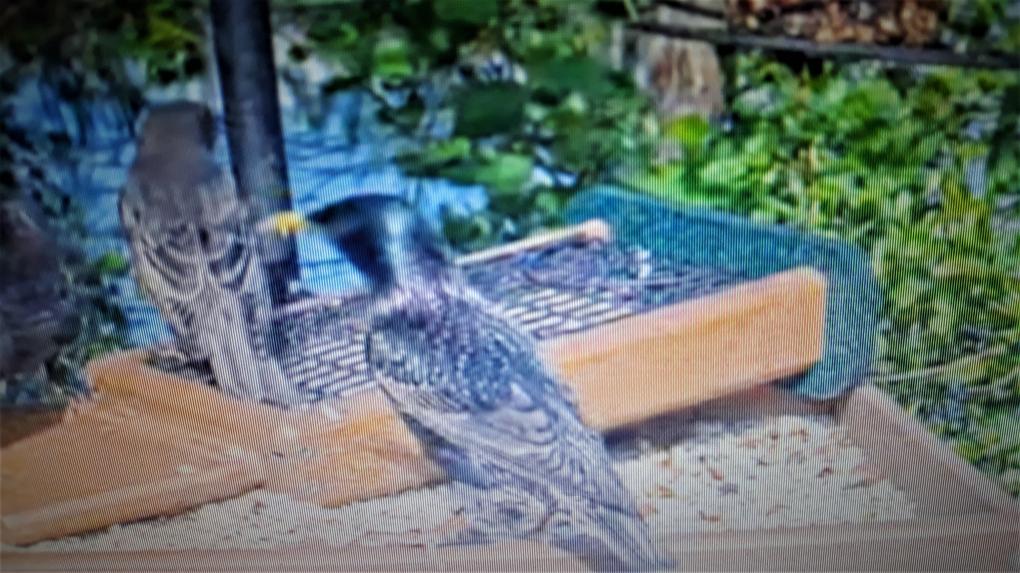
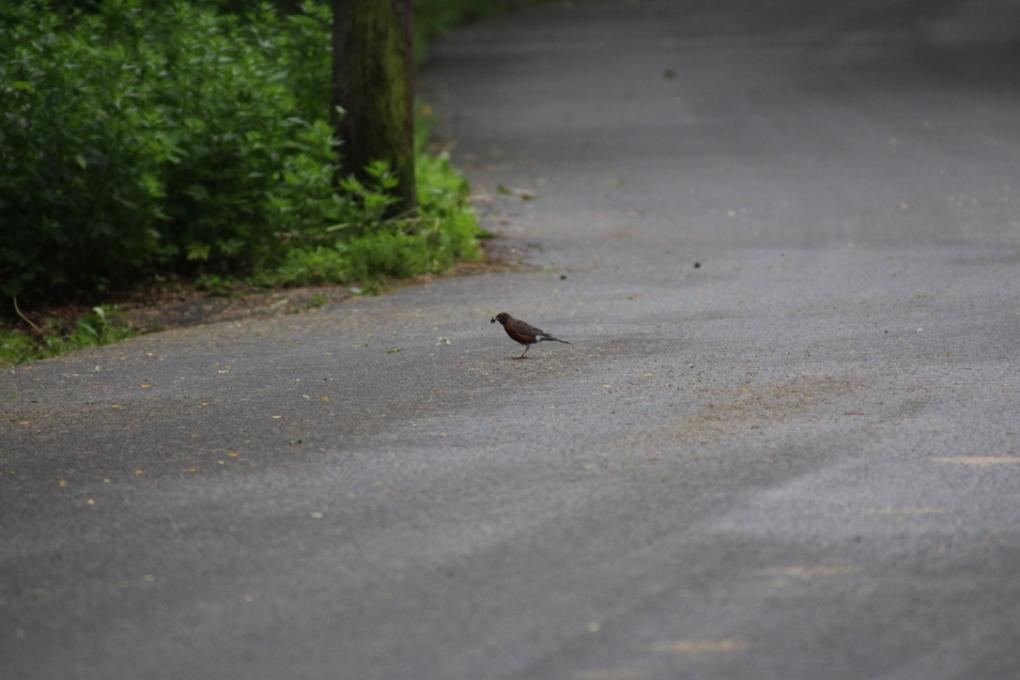
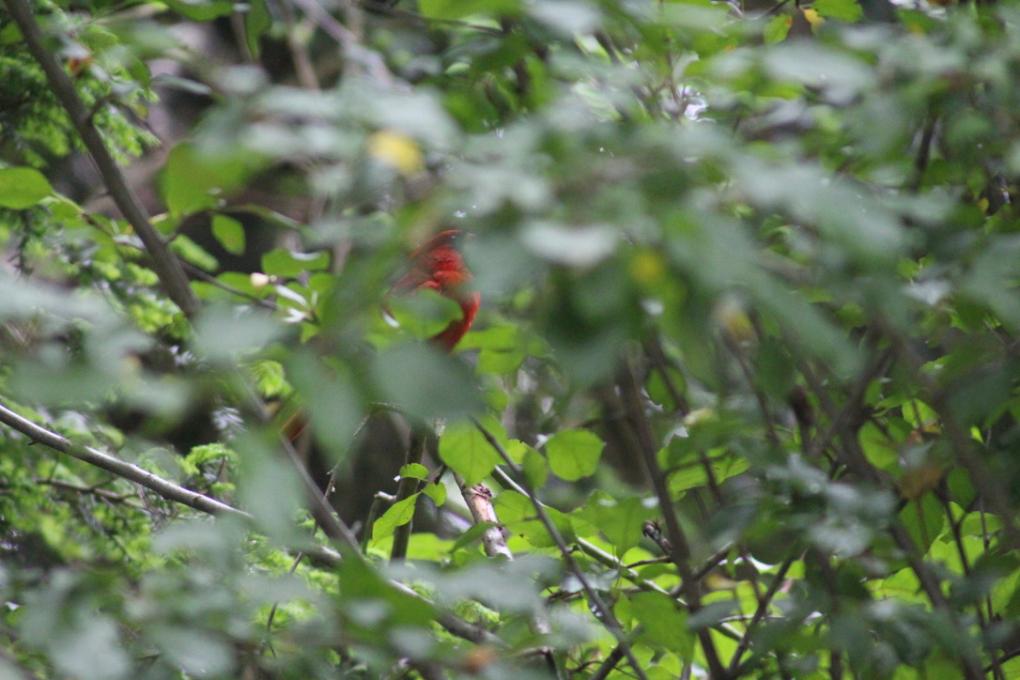 I looked around my house and was able to take photos of and ID a Northern Cardinal and American Robin. I used my camera because I don't have binoculars yet––and I learned how much of a challenge bird photography is! I'd love to get better at it. I used the Merlin app to identify them by color (both have red and black) but I think the app distinguished them based on behavior. The robin was on the ground while the cardinal was on a branch.
I looked around my house and was able to take photos of and ID a Northern Cardinal and American Robin. I used my camera because I don't have binoculars yet––and I learned how much of a challenge bird photography is! I'd love to get better at it. I used the Merlin app to identify them by color (both have red and black) but I think the app distinguished them based on behavior. The robin was on the ground while the cardinal was on a branch. 

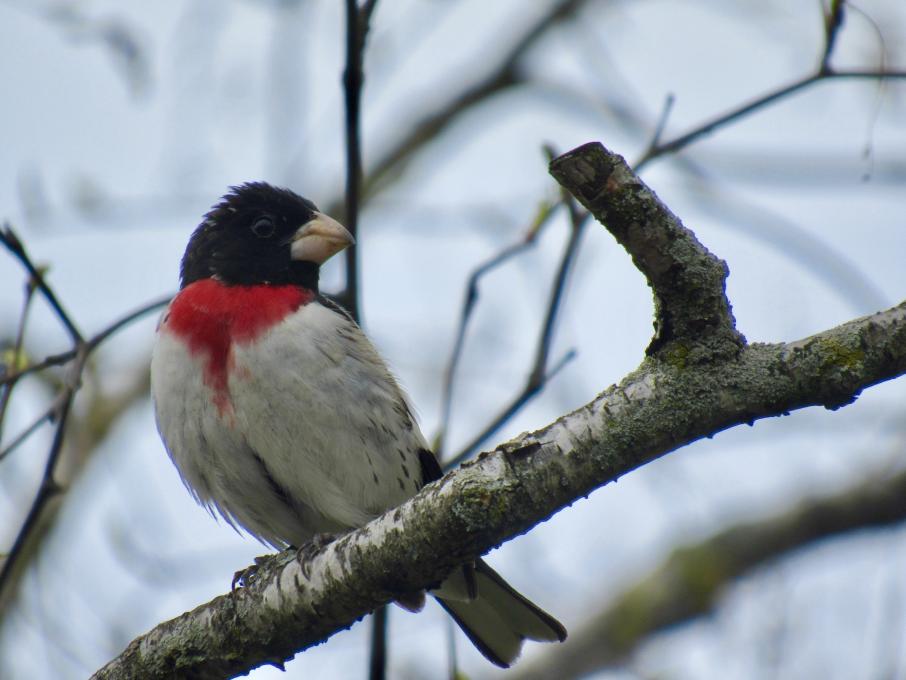 Activity #3: Today I watched a Nuthatch feed by going headfirst down a trunk. A Goldfinch ate seed from our feeder. And a Robin pulled a worm from the ground.
Activity #4: I took a walk this morning through a large town-owned field that has nesting boxes for Tree Swallows. These beautiful birds are about the size of a sparrow. They have stunning iridescent blue backs, while their underparts are white and their wings look black. They are very fast and agile flyers, swooping to feed on flying insects. To me, their song is a very high-pitched chirp that reminds of a piccolo.
Activity #3: Today I watched a Nuthatch feed by going headfirst down a trunk. A Goldfinch ate seed from our feeder. And a Robin pulled a worm from the ground.
Activity #4: I took a walk this morning through a large town-owned field that has nesting boxes for Tree Swallows. These beautiful birds are about the size of a sparrow. They have stunning iridescent blue backs, while their underparts are white and their wings look black. They are very fast and agile flyers, swooping to feed on flying insects. To me, their song is a very high-pitched chirp that reminds of a piccolo. 

